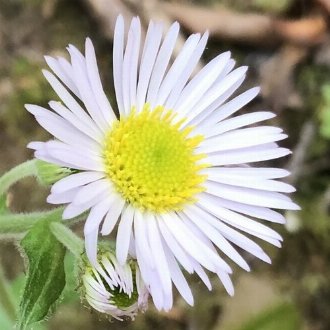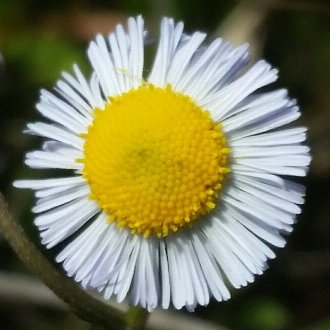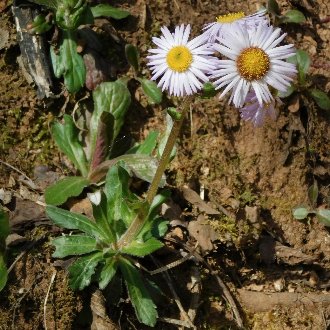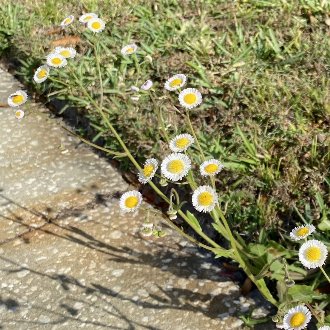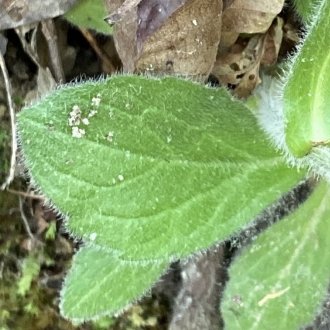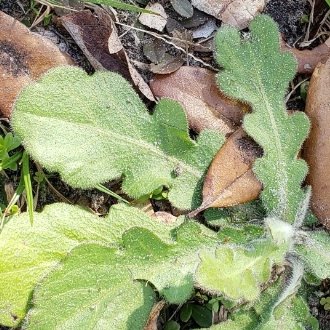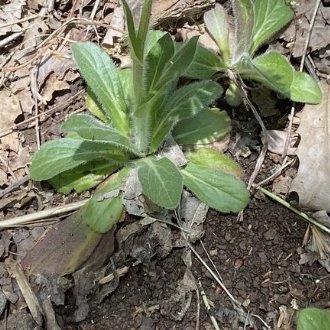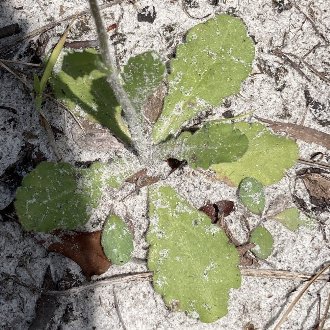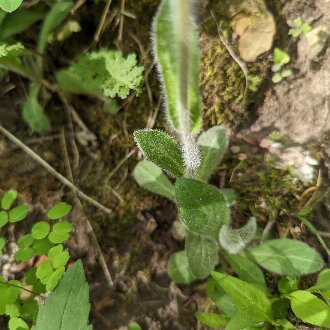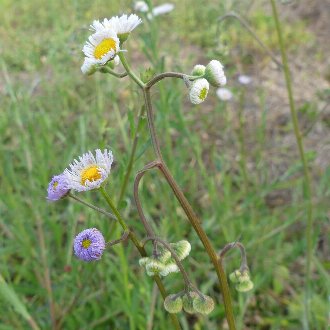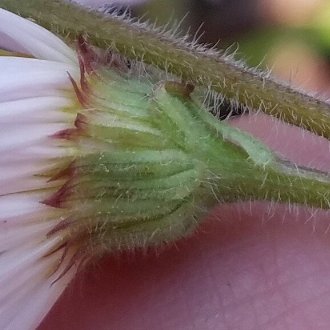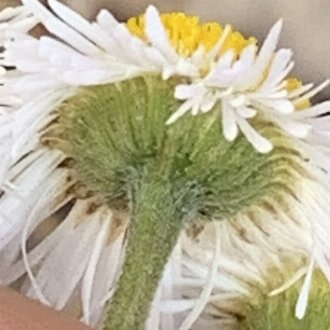Robin's Plantain vs Oakleaf Fleabane
These species are frequently confused in their reported range of overlap, as they have similar growth habits and height. They have little habitat overlap however, and they can be easily distinguished by flowers, growth habit, and basal leaves. E. quercifolius is restricted to the southeastern coastal plain, on sandy, peaty, or occasionally shell rock soils, and is usually found on moist, sunny, disturbed sites. E. pulchellus is predominately a more inland species, ranges onto finer-textured soils, often on slopes, and prefers better-drained, less-disturbed, shadier sites. In the zone of overlap it is most frequent on the upper slopes of riparian forests in areas where streams have dissected the terrain, leading to steeper slopes than is typical in the coastal plain; it is also often more common on calcareous soils, but not restricted to these soils.
Robin's Plantain (Erigeron pulchellus) | Oakleaf Fleabane (Erigeron quercifolius) |
A perennial favoring slightly dry sites of low soil fertility in open woodlands. | An annual, biennial, or short-lived perennial native to sandy sites in Florida and nearby portions of the Atlantic and Gulf coasts. |
Flowerheads are larger (about 1-1.5in or 2.5-3.8cm), with fewer (50-80, rarely to 100), wider, longer (6–10mm) rays. Photo © Scott Morris, CC BY 4.0. | Flowerheads are smaller (about 0.24-0.5in or 0.64-1.27cm), with more numerous (100-150), narrower, shorter (2.5-6mm) rays. Photo © Jay Horn, CC BY 4.0. |
Stems branch less, and usually have 1-4 (rarely to 9) flowerheads. Branches in the inflorescence are very short, leading flowerheads to cluster closely together. Photo © mjpapay, CC BY 4.0. | Stems branch more, and usually have 4-16 (rarely 1-50) flowerheads. Branches in the inflorescence can be much longer. Photo © Karen Guin, CC BY 4.0. |
Margins of basal leaves are usually covered in subtle, shallow, but sharp teeth. Leaves never have large or deep lobes, and may lack teeth entirely. Pubescence on leaves is coarser, leading foliage to look darker in color and individual hairs to be more visible in photographs. Photo © Carol Ann McCormick, CC BY 4.0. | Basal leaves are usually pinnately lobed. Lobes may be rounded or sharp-tipped; leaves with sharp-tipped lobes may look coarsely serrated, but leaves never lack lobes or teeth entirely. Pubescence on leaves is dense and fine, leading foliage to look paler and hairs to be less visible from a distance. Photo © Jeanene Arrington-Fisher, CC BY 4.0. |
Although it can occur on sandy soils, it also ranges into clayey and loamy soils, and although it can occur under pines, it is more likely under the shade of deciduous trees. Photo © emerlee, CC BY 4.0. | Not usually found on clayey or loamy soils. Usually found in sandy soils, occasionally found on shell rock or on peaty soils. Photo © Jade Fortnash, Public Domain. |
Prefers drier, less disturbed habitats, but restricted to well-drained sites; more likely in forests on sites where difficult soil conditions create an open understory. Often found on slopes. Photo © Ryan Sorrells, CC BY 4.0. | Prefers moister, more disturbed habitats, including lawns, along roadsides, and vacant lots, including in ditches and other low, wet areas. Most often found on flat terrain. Photo © Valerie Anderson, CC BY 4.0. |
Involucres (cluster of bracts under each flowerhead) are longer (5-7mm) and often look much longer relative to their width. Photo © Leila Dasher, CC BY 4.0. | Involucres are shorter (2.5–4mm) and often appear flatter due to being much wider relative to their depth. Photo © natalie, Public Domain. |
Additional Notes
Both of these species can be confused with Philadelphia fleabane (Erigeron philadelphicus), which also has leaves that clasp the stem. That species tends to have even narrower, more numerous rays than E. quercifolius, and it also tends to grow taller and have more foliage on the stem than either of these species.Because E. pulchellus is sometimes planted in gardens, occasionally you will find it, usually a cultivar, growing on sites where it would not occur in the wild, including in full sun in sandy soils in the coastal plain, or in low, moist sites.
References & External Resources
These short lists show only links helpful for ID. For a complete list of references and resources also covering other aspects of ecology, visit the links section of the full article on each plant, which is the first entry here.



